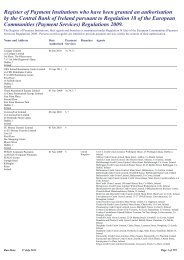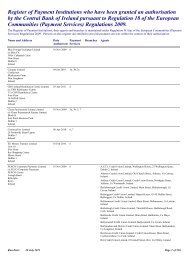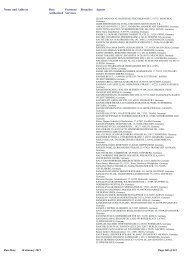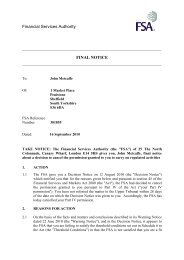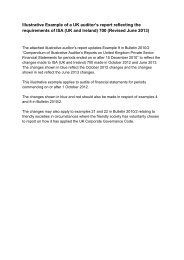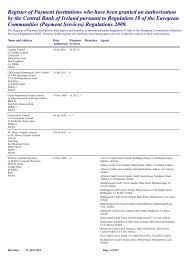Consultation Paper on the draft proposal for ... - Eiopa - Europa
Consultation Paper on the draft proposal for ... - Eiopa - Europa
Consultation Paper on the draft proposal for ... - Eiopa - Europa
Create successful ePaper yourself
Turn your PDF publications into a flip-book with our unique Google optimized e-Paper software.
Guideline 25 Differences between <strong>the</strong> standard <strong>for</strong>mula and any internal<br />
model used<br />
Undertakings should c<strong>on</strong>sider, when disclosing <strong>the</strong> differences between<br />
Standard Formula and Internal Models:<br />
a) Structure of <strong>the</strong> model,<br />
b) Risk categories c<strong>on</strong>cerned by internal models and those not,<br />
c) Aggregati<strong>on</strong> methodologies and diversificati<strong>on</strong> effects,<br />
d) Risk not covered in <strong>the</strong> Standard Formula but in <strong>the</strong> internal<br />
model,<br />
e) High level differences in <strong>the</strong> methodologies.<br />
4.63. Undertakings accompany quantitative in<strong>for</strong>mati<strong>on</strong> by a descripti<strong>on</strong> of <strong>the</strong><br />
main feature of <strong>the</strong> internal model in order not to mislead readers of <strong>the</strong><br />
quantitative reporting templates and to ensure a better understanding.<br />
4.64. It is impossible a priori to assess whe<strong>the</strong>r <strong>the</strong> methodologies used in an<br />
internal model will be close or similar to <strong>the</strong> <strong>on</strong>e used in <strong>the</strong> standard<br />
<strong>for</strong>mula. Never<strong>the</strong>less, undertakings may have chosen in <strong>the</strong>ir internal<br />
model to use terminologies that are close to <strong>the</strong> <strong>on</strong>e used in <strong>the</strong><br />
standard <strong>for</strong>mula.<br />
4.65. In particular, it is avoided to base comparis<strong>on</strong>s between <strong>the</strong> quantitative<br />
outputs of two different undertakings that would have used <strong>the</strong> same<br />
name <strong>for</strong> some modules although:<br />
• They may cover different risks;<br />
• They may use totally different approaches.<br />
4.66. This is why undertakings provide a high-level descripti<strong>on</strong> of <strong>the</strong> model.<br />
4.67. Besides, modelling of diversificati<strong>on</strong> effects was <strong>on</strong>e of <strong>the</strong> main flaws<br />
detected in internal models in <strong>the</strong> global financial crisis and is a key<br />
driver in <strong>the</strong> internal models results. The disclosure of <strong>the</strong>se will<br />
simultaneously boost <strong>the</strong> public c<strong>on</strong>fidence in internal models and also<br />
have a disciplinary effect <strong>on</strong> <strong>the</strong> market.<br />
4.68. Because some risks that are material to an undertaking may not be<br />
explicitly included in <strong>the</strong> standard <strong>for</strong>mula. Never<strong>the</strong>less, in order to<br />
meet article 121(4) of <strong>the</strong> Directive 2009/138/EC, <strong>the</strong>y would have<br />
included <strong>the</strong>se risks in <strong>the</strong>ir internal model. This in<strong>for</strong>mati<strong>on</strong> seems to be<br />
of <strong>the</strong> upmost importance in order to analyse properly <strong>the</strong> reported<br />
quantitative in<strong>for</strong>mati<strong>on</strong>.<br />
36/51<br />
© EIOPA 2011



